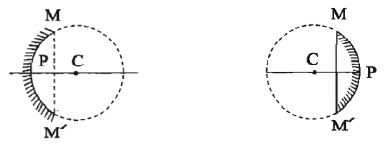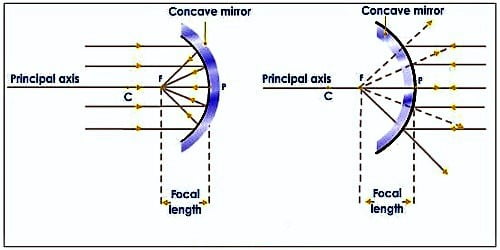A mirror is a smooth surface on which regular reflection takes place. A clear image of an object placed in front of a mirror is formed due to the reflection of light. A flat and well-polished reflecting surface area is a mirror. When a mirror reflects light, it forms an image. An image is a copy of an object that is formed by reflection or refraction.
A mirror is made by giving a reflecting coating on a smooth surface. Generally, a mirror is prepared by giving metal coating on one surface of the glass. This process of coating with mercury or silver on glass is called silvering. Here, the surface opposite to the surface having metal coating works as the reflecting surface. Besides, the surface of calm water, smooth ice, etc. work as a mirror.
Mirrors are mainly of two types. Namely-
- Plane mirror
- Spherical mirror
Plane mirror: If the reflecting surface is a plain and smooth and regular reflection of light takes place on it, then this surface is called a plane mirror. It has a smooth reflective surface and forms only virtual images. The image formed by a plane mirror is also right-side up and life-sized. This is the most general type of mirror used in bedrooms and bathrooms. The mirror which we usually use is a plane mirror.
Spherical mirror: If the reflecting surface is smooth and spherical, that means if the reflecting surface is a part of a sphere and regular reflection takes place on it, it is called the spherical mirror. A spherical mirror is a mirror which has the form of a piece cut out of a spherical surface. Spherical mirrors are shown in figures (1) and (2). If a part of a hollow glass sphere is cut off and silvering is done on one surface, then a spherical mirror is made. It is constructed in such a method that one side of it is opaque whereas the other side of it is a well polished reflecting surface. Again, spherical mirrors are of two types.
These are: 1. Concave mirror 2. Convex mirror
Concave mirror: If the concave surface of a sphere acts as the reflector, that is if a regular reflection of light takes place from the concave surface of the spherical mirror, then it is called a concave mirror. A concave mirror is shaped like the inside of a bowl. This type of mirror forms either real or virtual images, depending on where the object is placed relative to the focal point. In this case, the concave mirror is made by silvering on the convex surface of the part of the sphere [figure 1]. The concave mirror is a converging mirror since the parallel beam of light converges at a point or meets together after reflection from its surface.
A concave mirror is also known as the converging mirror as in these type of mirrors light rays converge at a point after they strike and are getting reflecting back from the reflecting surface of the mirror. They form the illusion of largeness and are typically found in bathrooms and bedrooms.

Fig (1) Fig(2)
Convex mirror: If the convex surface of a sphere acts as the reflector, that is if the regular reflection of light takes place from the convex surface of the spherical mirror, then it is called a convex mirror. These mirrors are “always” form virtual, erect and diminished regardless of the distance between the object and mirror. In this case, a convex mirror is made by silvering on the concave or inner surface of the part of the sphere [Figure 1]. The convex mirror is a diverging mirror since the parallel beam of light diverges from a point or spreads over and never meets at a point after reflection [Figure 2]. However, unlike concave mirrors, they bulge out and distort the reflected image, making it smaller.













